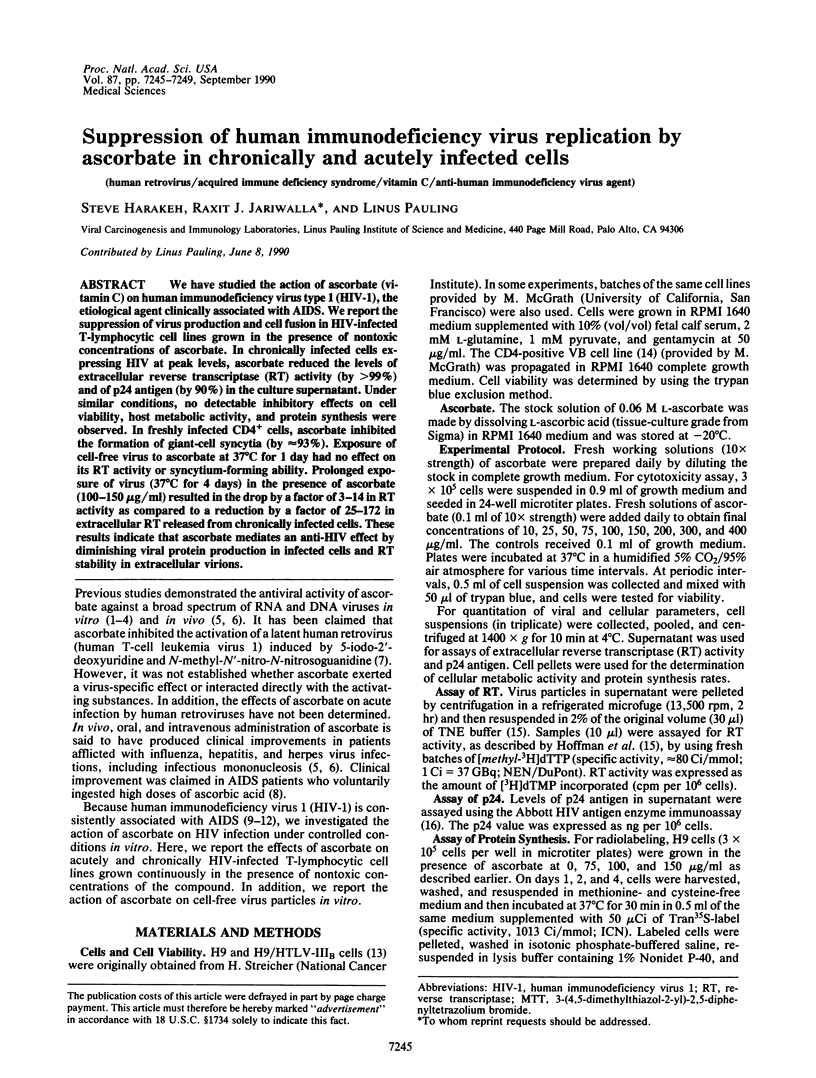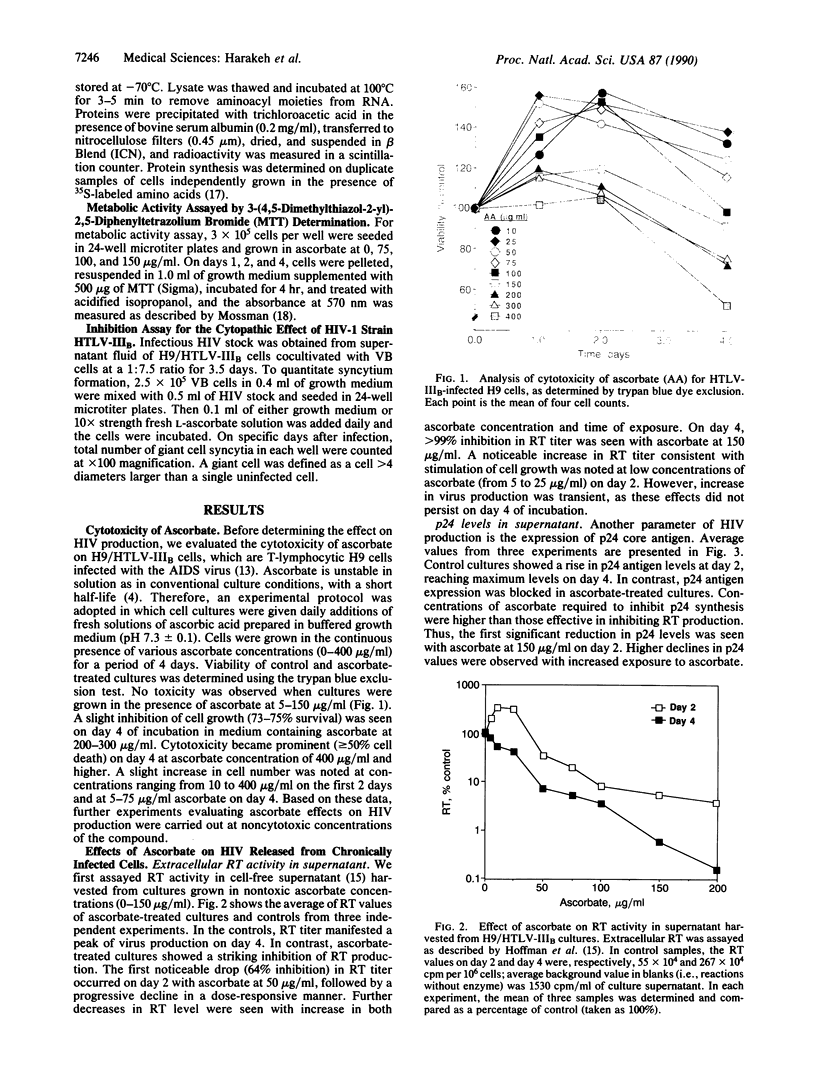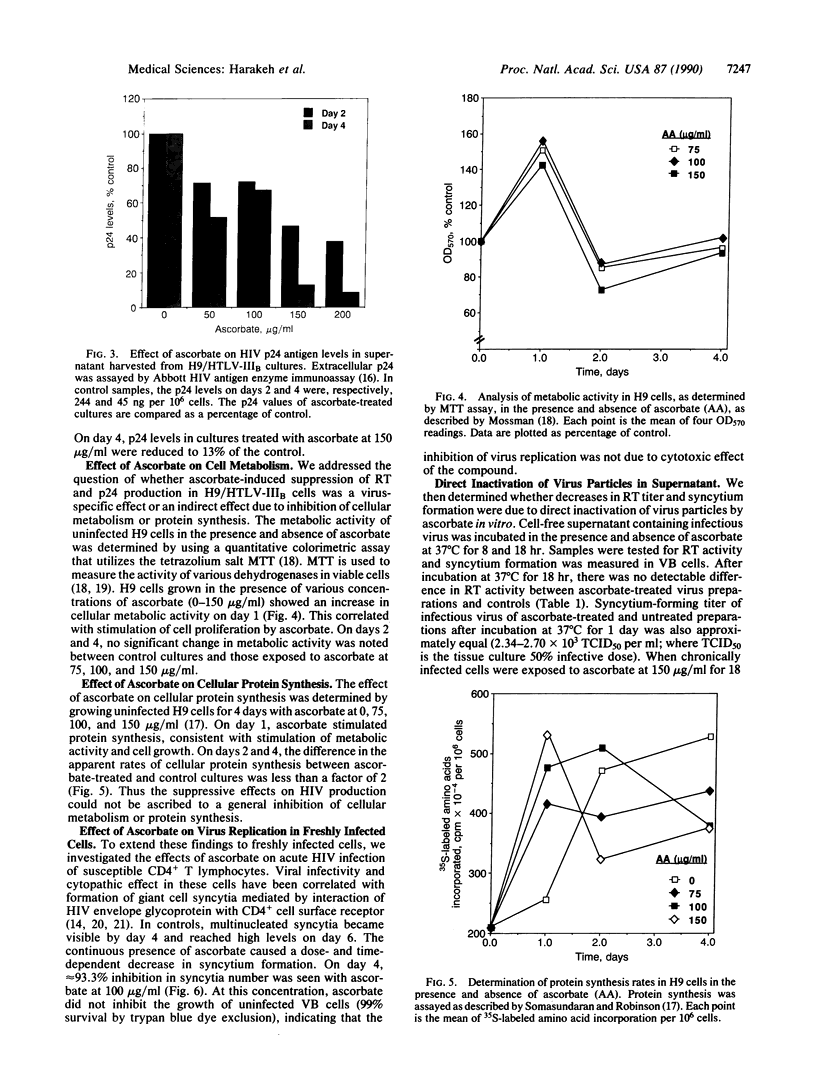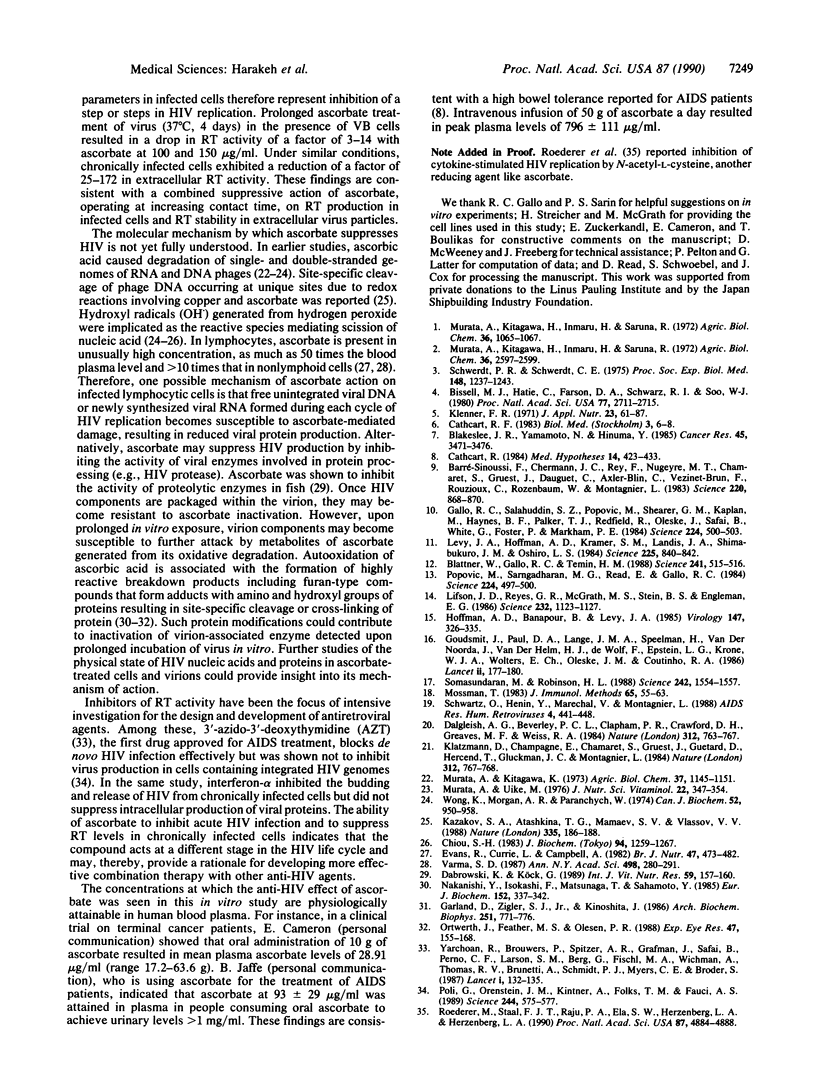Abstract
We have studied the action of ascorbate (vitamin C) on human immunodeficiency virus type 1 (HIV-1), the etiological agent clinically associated with AIDS. We report the suppression of virus production and cell fusion in HIV-infected T-lymphocytic cell lines grown in the presence of nontoxic concentrations of ascorbate. In chronically infected cells expressing HIV at peak levels, ascorbate reduced the levels of extracellular reverse transcriptase (RT) activity (by greater than 99%) and of p24 antigen (by 90%) in the culture supernatant. Under similar conditions, no detectable inhibitory effects on cell viability, host metabolic activity, and protein synthesis were observed. In freshly infected CD4+ cells, ascorbate inhibited the formation of giant-cell syncytia (by approximately 93%). Exposure of cell-free virus to ascorbate at 37 degrees C for 1 day had no effect on its RT activity or syncytium-forming ability. Prolonged exposure of virus (37 degrees C for 4 days) in the presence of ascorbate (100-150 micrograms/ml) resulted in the drop by a factor of 3-14 in RT activity as compared to a reduction by a factor of 25-172 in extracellular RT released from chronically infected cells. These results indicate that ascorbate mediates an anti-HIV effect by diminishing viral protein production in infected cells and RT stability in extracellular virions.
Full text
PDF




Images in this article
Selected References
These references are in PubMed. This may not be the complete list of references from this article.
- Barré-Sinoussi F., Chermann J. C., Rey F., Nugeyre M. T., Chamaret S., Gruest J., Dauguet C., Axler-Blin C., Vézinet-Brun F., Rouzioux C. Isolation of a T-lymphotropic retrovirus from a patient at risk for acquired immune deficiency syndrome (AIDS). Science. 1983 May 20;220(4599):868–871. doi: 10.1126/science.6189183. [DOI] [PubMed] [Google Scholar]
- Bissell M. J., Hatie C., Farson D. A., Schwarz R. I., Soo W. J. Ascorbic acid inhibits replication and infectivity of avian RNA tumor virus. Proc Natl Acad Sci U S A. 1980 May;77(5):2711–2715. doi: 10.1073/pnas.77.5.2711. [DOI] [PMC free article] [PubMed] [Google Scholar]
- Blakeslee J. R., Jr, Yamamoto N., Hinuma Y. Human T-cell leukemia virus I induction by 5-iodo-2'-deoxyuridine and N-methyl-N'-nitro-N-nitrosoguanidine: inhibition by retinoids, L-ascorbic acid, and DL-alpha-tocopherol. Cancer Res. 1985 Aug;45(8):3471–3476. [PubMed] [Google Scholar]
- Blattner W., Gallo R. C., Temin H. M. HIV causes AIDS. Science. 1988 Jul 29;241(4865):515–516. doi: 10.1126/science.3399881. [DOI] [PubMed] [Google Scholar]
- Cathcart R. F., 3rd Vitamin C in the treatment of acquired immune deficiency syndrome (AIDS). Med Hypotheses. 1984 Aug;14(4):423–433. doi: 10.1016/0306-9877(84)90149-x. [DOI] [PubMed] [Google Scholar]
- Chiou S. H. DNA- and protein-scission activities of ascorbate in the presence of copper ion and a copper-peptide complex. J Biochem. 1983 Oct;94(4):1259–1267. doi: 10.1093/oxfordjournals.jbchem.a134471. [DOI] [PubMed] [Google Scholar]
- Dabrowski K., Köck G. The effect of ascorbate on proteolytic enzyme activities in fish. Int J Vitam Nutr Res. 1989;59(2):157–160. [PubMed] [Google Scholar]
- Dalgleish A. G., Beverley P. C., Clapham P. R., Crawford D. H., Greaves M. F., Weiss R. A. The CD4 (T4) antigen is an essential component of the receptor for the AIDS retrovirus. Nature. 1984 Dec 20;312(5996):763–767. doi: 10.1038/312763a0. [DOI] [PubMed] [Google Scholar]
- Evans R. M., Currie L., Campbell A. The distribution of ascorbic acid between various cellular components of blood, in normal individuals, and its relation to the plasma concentration. Br J Nutr. 1982 May;47(3):473–482. doi: 10.1079/bjn19820059. [DOI] [PubMed] [Google Scholar]
- Gallo R. C., Salahuddin S. Z., Popovic M., Shearer G. M., Kaplan M., Haynes B. F., Palker T. J., Redfield R., Oleske J., Safai B. Frequent detection and isolation of cytopathic retroviruses (HTLV-III) from patients with AIDS and at risk for AIDS. Science. 1984 May 4;224(4648):500–503. doi: 10.1126/science.6200936. [DOI] [PubMed] [Google Scholar]
- Garland D., Zigler J. S., Jr, Kinoshita J. Structural changes in bovine lens crystallins induced by ascorbate, metal, and oxygen. Arch Biochem Biophys. 1986 Dec;251(2):771–776. doi: 10.1016/0003-9861(86)90389-9. [DOI] [PubMed] [Google Scholar]
- Goudsmit J., de Wolf F., Paul D. A., Epstein L. G., Lange J. M., Krone W. J., Speelman H., Wolters E. C., Van der Noordaa J., Oleske J. M. Expression of human immunodeficiency virus antigen (HIV-Ag) in serum and cerebrospinal fluid during acute and chronic infection. Lancet. 1986 Jul 26;2(8500):177–180. doi: 10.1016/s0140-6736(86)92485-2. [DOI] [PubMed] [Google Scholar]
- Hoffman A. D., Banapour B., Levy J. A. Characterization of the AIDS-associated retrovirus reverse transcriptase and optimal conditions for its detection in virions. Virology. 1985 Dec;147(2):326–335. doi: 10.1016/0042-6822(85)90135-7. [DOI] [PubMed] [Google Scholar]
- Kazakov S. A., Astashkina T. G., Mamaev S. V., Vlassov V. V. Site-specific cleavage of single-stranded DNAs at unique sites by a copper-dependent redox reaction. Nature. 1988 Sep 8;335(6186):186–188. doi: 10.1038/335186a0. [DOI] [PubMed] [Google Scholar]
- Klatzmann D., Champagne E., Chamaret S., Gruest J., Guetard D., Hercend T., Gluckman J. C., Montagnier L. T-lymphocyte T4 molecule behaves as the receptor for human retrovirus LAV. Nature. 1984 Dec 20;312(5996):767–768. doi: 10.1038/312767a0. [DOI] [PubMed] [Google Scholar]
- Levy J. A., Hoffman A. D., Kramer S. M., Landis J. A., Shimabukuro J. M., Oshiro L. S. Isolation of lymphocytopathic retroviruses from San Francisco patients with AIDS. Science. 1984 Aug 24;225(4664):840–842. doi: 10.1126/science.6206563. [DOI] [PubMed] [Google Scholar]
- Lifson J. D., Reyes G. R., McGrath M. S., Stein B. S., Engleman E. G. AIDS retrovirus induced cytopathology: giant cell formation and involvement of CD4 antigen. Science. 1986 May 30;232(4754):1123–1127. doi: 10.1126/science.3010463. [DOI] [PubMed] [Google Scholar]
- Mosmann T. Rapid colorimetric assay for cellular growth and survival: application to proliferation and cytotoxicity assays. J Immunol Methods. 1983 Dec 16;65(1-2):55–63. doi: 10.1016/0022-1759(83)90303-4. [DOI] [PubMed] [Google Scholar]
- Murata A., Uike M. Mechanism of inactivation of bacteriophage MS2 containing single-stranded RNA by ascorbic acid. J Nutr Sci Vitaminol (Tokyo) 1976;22(5):347–354. doi: 10.3177/jnsv.22.347. [DOI] [PubMed] [Google Scholar]
- Nakanishi Y., Isohashi F., Matsunaga T., Sakamoto Y. Oxidative inactivation of an extramitochondrial acetyl-CoA hydrolase by autoxidation of L-ascorbic acid. Eur J Biochem. 1985 Oct 15;152(2):337–342. doi: 10.1111/j.1432-1033.1985.tb09203.x. [DOI] [PubMed] [Google Scholar]
- Ortwerth B. J., Feather M. S., Olesen P. R. The precipitation and cross-linking of lens crystallins by ascorbic acid. Exp Eye Res. 1988 Jul;47(1):155–168. doi: 10.1016/0014-4835(88)90032-2. [DOI] [PubMed] [Google Scholar]
- Poli G., Orenstein J. M., Kinter A., Folks T. M., Fauci A. S. Interferon-alpha but not AZT suppresses HIV expression in chronically infected cell lines. Science. 1989 May 5;244(4904):575–577. doi: 10.1126/science.2470148. [DOI] [PubMed] [Google Scholar]
- Popovic M., Sarngadharan M. G., Read E., Gallo R. C. Detection, isolation, and continuous production of cytopathic retroviruses (HTLV-III) from patients with AIDS and pre-AIDS. Science. 1984 May 4;224(4648):497–500. doi: 10.1126/science.6200935. [DOI] [PubMed] [Google Scholar]
- Roederer M., Staal F. J., Raju P. A., Ela S. W., Herzenberg L. A., Herzenberg L. A. Cytokine-stimulated human immunodeficiency virus replication is inhibited by N-acetyl-L-cysteine. Proc Natl Acad Sci U S A. 1990 Jun;87(12):4884–4888. doi: 10.1073/pnas.87.12.4884. [DOI] [PMC free article] [PubMed] [Google Scholar]
- Schwartz O., Henin Y., Marechal V., Montagnier L. A rapid and simple colorimetric test for the study of anti-HIV agents. AIDS Res Hum Retroviruses. 1988 Dec;4(6):441–448. doi: 10.1089/aid.1988.4.441. [DOI] [PubMed] [Google Scholar]
- Schwerdt P. R., Schwerdt C. E. Effect of ascorbic acid on rhinovirus replication in WI-38 cells. Proc Soc Exp Biol Med. 1975 Apr;148(4):1237–1243. doi: 10.3181/00379727-148-38724. [DOI] [PubMed] [Google Scholar]
- Somasundaran M., Robinson H. L. Unexpectedly high levels of HIV-1 RNA and protein synthesis in a cytocidal infection. Science. 1988 Dec 16;242(4885):1554–1557. doi: 10.1126/science.3201245. [DOI] [PubMed] [Google Scholar]
- Varma S. D. Ascorbic acid and the eye with special reference to the lens. Ann N Y Acad Sci. 1987;498:280–306. doi: 10.1111/j.1749-6632.1987.tb23768.x. [DOI] [PubMed] [Google Scholar]
- Wong K., Morgan A. R., Paranchych W. Controlled cleavage of phage R17 RNA within the virion by treatment with ascorbate and copper (II). Can J Biochem. 1974 Nov;52(11):950–958. doi: 10.1139/o74-133. [DOI] [PubMed] [Google Scholar]
- Yarchoan R., Berg G., Brouwers P., Fischl M. A., Spitzer A. R., Wichman A., Grafman J., Thomas R. V., Safai B., Brunetti A. Response of human-immunodeficiency-virus-associated neurological disease to 3'-azido-3'-deoxythymidine. Lancet. 1987 Jan 17;1(8525):132–135. doi: 10.1016/s0140-6736(87)91968-4. [DOI] [PubMed] [Google Scholar]




